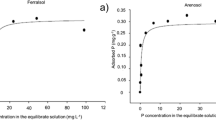Abstract
The effect of two P-forms and the P fertilization system were studied in field trials set up on two moderately acidic Hungarian soils. Reactive Algerian rock phosphate and Kola superphosphate doses were based on the phosphorus equivalence. The experimental design makes it possible to compare the effect of annual 35 kg/ha P doses with initial one-time application of the 175 kg/ha P level in a five-year interval. Ammonium-lactate (AL)-, NaHCO3 (Olsen)- and DW-P contents as well as Lakanen- Erviö (LE)- soluble Cd, Cr and Sr contents were also determined. The results of the first five-year period are reported in the paper. Responses to P fertilization were related to the original P supply of the soils. There was no significant difference between the two P forms and between the P fertilization systems on both grain yield and P-uptake. While AL- method overestimated, and Olsen-method – on the other hand – underestimated the P supply of reactive Algerian rock phosphate, distilled water (DW)-soluble P contents indicated the soil P status more accurately. Phosphorus balances were positive after the fifth year of the trials in the P treated plots. The soluble Cd and Cr contents did not increase in the Algerian rock phosphate treated plots. On the other hand, Kola superphosphate application at 175 kg/ha P level resulted in higher LE-Sr contents in soils. The Algerian rock phosphate is an economic alternative P source on the moderately or strongly acidic Hungarian soils.
Similar content being viewed by others
References
Adediran JA, Oguntoyinbo FI, Omonode R & Sobul RA (1989) Evaluation of phosphorus availability from three phosphorus sources in Nigerian soils. Commun Soil Sci Plant Anal 29: 2659–2673
Bésán J (1992) The role of rock phosphate based fertilizers in economic plant nutrition. Agrofórum 1992/1. Suppl 41–43. (In Hungarian)
Bolan NS & Hedley MJ (1989) Dissolution of phosphate rocks in soils. I. Comparison of extraction methods to measure dissolution. Fertil Res 19: 65–75
Bolan NS & Hedley MJ (1990) Dissolution of phosphate rocks in soils. 2. Effect of pH on the dissolution and plant availability of phosphate rock in soil with pH dependent charge. Fertil Res 24: 15–134
Bolland MDA, Weatherly AJ & Gilkes RJ (1989) The long-term residual value of rock phosphate and superphosphate fertilizers for various plant species under field conditions. Fertil Res 20: 89–100
Bolland MDA (1993) Summary of research on soil testing for rock phosphate fertilizers in Western Australia. Fertil Res 35: 83–91
Cornforth IS, Smith GS & Fox RL (1983) Phosphate extractability and availability to plants in phosphate rock-treated soils. NZ J Exper Agric 11: 243–246
Egner H, Riehm H & Domingo WR (1960) Untersuchungen über die chemische Bodenanalyse als Grundlage für die Beurteilung des Nahrstoffzustandes der Böden. II. Lantbr Högsk Ann 26: 199–215
Engelstad OP & Terman GL (1980). Agronomic effectiveness of phosphate fertilizers. In: Khasawneh FE, Sample EC & Kamprath EJ (eds) The role of phosphorus in agriculture, pp 311–332. American Society of Agronomy, Crop Science Society of America, Soil Science Society of America, Madison, Wisconsin, USA
Hedley MJ & Bolan NS (1997) Developments in some aspects of reactive phosphate rock research and use in New Zeland. Aust J Exper Agric 37: 861–884
Krámer M (1962) Data on the effects of North African (Hyper) and Israel (Cyklon) phosphates. Agrokémia és Talajtan 11: 335–344. (In Hungarian)
Kumar V, Gilkes RJ & Bolland MDA (1992) A comparison of seven soil P test for plant species with different external P requirements grown on soil containing rock phosphate and superphosphate residues. Fertil Res 33: 35–45
Lakanen E & Erviö R (1971) A comparison of eight extractants for the determination of plant available micronutrients in soil. Acta Agr Fenn 123: 223–232
Lehr JR (1980) Phosphate raw materials and fertilizers: Part I — A look ahead. In: Khasawneh FE, Sample EC, Kamprath EJ (eds) The role of phosphorus in agriculture, pp 81–120. American Society of Agronomy, Crop Science Society of America, Soil Science Society of America, Madison, Wisconsin, USA
Mackay AD, Syers JK, Gregg PEH & Tillman RW (1984) A comparison of 3 soil testing procedures for estimating the plant availability of phosphorus in soils receiving either superphosphate or phosphate rock. NZ J Agric Res 27: 231–245
Mahimairaja S, Bolan NS & Hedley MJ (1995) Dissolution of phosphate rock during the composting of poultry manure: an incubation experiment. Fertil Res 40: 93–104
Mártonffy T & Pekáry K (1978) Comparison of the nutritive effect of single and complex fertilizers and hyperphosphate in the scope of the Unified National Long-term Fertilization Trials. Növénytermelés 27: 247–254. (In Hungarian)
Menon RG & Chien SH (1995) Soil testing for available phosphorus in soils where phosphate rock-based fertilizers are used. Fertil Res 41: 179–187
Olsen SR, Cole CV, Watanabe FS & Dean LA (1954) Estimation of available phosphorus in soils by extraction with sodium bicarbonate. US Dept. Agric. Circular No. 939
Perrott KW, Saggar S & Menon RG (1993) Evaluation of soil phosphate status where phosphate rock based fertilizers have been used. Fertil Res 35: 67–82
Sarkadi J (1982) Opredelenie ‘vodorasztvorimogo’ foszfora. In: Agrochemische Methoden für die Untersuchung des phosphathaushaltes des Böden: Methodensammlung. 1–13. Ak. der Landw. DDR. IPE. Jena
Sik K (1964) Vergleichende Dauerversuche mit feingranulierten Rohphosphaten auf drei Bodentypen in Ungarn. Agrokémia és Talajtan 13Suppl: 139–146
Tyurin IV (1951) K metodike analiza dlja szravnitelnogo izucsenija szosztava pocsvennogo gumusza. Trudü Pocsvennogo Instituta. A. N. Sz. Sz. Sz. R
Várallyay G, Szücs L, Muranyi A, Rajkai K & Zilahy P (1980) Map of soil factors determining the agro-ecological potential of Hungary II. Agrokémia és Talajtan 29: 35–76
Author information
Authors and Affiliations
Corresponding author
Rights and permissions
About this article
Cite this article
Németh, T., Magyar, M., Csathó, P. et al. Long-term field evaluation of phosphate rock and superphosphate use strategies in acid soils of Hungary: Two comparative field trials. Nutrient Cycling in Agroecosystems 63, 81–89 (2002). https://doi.org/10.1023/A:1020529001629
Issue Date:
DOI: https://doi.org/10.1023/A:1020529001629




